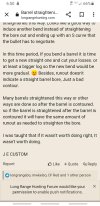340 in Va
Well-Known Member
There's a fantastic episode of the Hornady podcasts with Jeff Siewert (spelling could be wrong) that talks about this and many other items. Barrel specific.
He is one of the worlds foremost barrel testers and examiners for the military.
With your point in particular, I remember there being cases where non concentric barrels being more accurate than some that are due to 'disturbed vibration' (think harmonics) and a bunch of other idiosyncrasies.
Anyway, better to watch the podcast rather than listen to me.
Really informative.
Thanks for the post, may take some time to digest. Can you believe 30-06 165 gr. was his bullet and cal. of choice? That should start a fire storm. I just finished load development on 06 with 165 interbonds for wife's Tikka yesterday.

